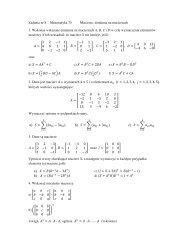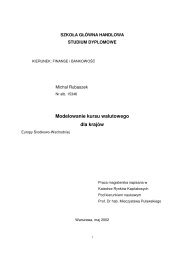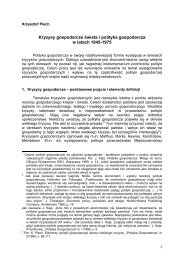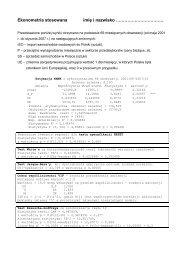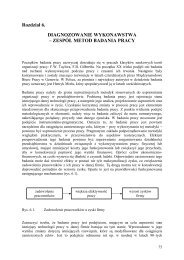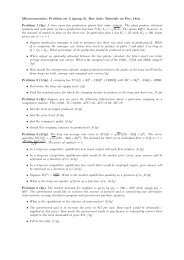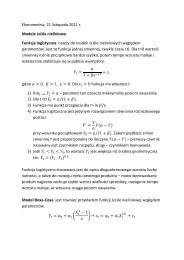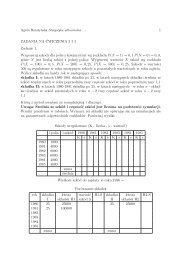“Airbus vs. Boeing in Super Jumbos: A Case of Failed Preemptionâ€Â
“Airbus vs. Boeing in Super Jumbos: A Case of Failed Preemptionâ€Â
“Airbus vs. Boeing in Super Jumbos: A Case of Failed Preemptionâ€Â
You also want an ePaper? Increase the reach of your titles
YUMPU automatically turns print PDFs into web optimized ePapers that Google loves.
described below). If one were to view the risk shar<strong>in</strong>g capital or launch aid contributionsas debt, then it would be necessary to account for the value derived from <strong>in</strong>terest taxshields us<strong>in</strong>g either a levered cost <strong>of</strong> capital such as the weighted average cost <strong>of</strong> capital(WACC) or an alternative valuation method such as the adjusted present value (APV, seeMyers, 1974). This assumption also means that our operat<strong>in</strong>g marg<strong>in</strong>s must be beforerepayment <strong>of</strong> capital contributions. A second important assumption is that we estimateproject value as <strong>of</strong> year-end 2000, the date at which Airbus’ supervisory board made the“go/no go” decision, and have ignored all expenditures prior to that date. By its ownaccount, Airbus has spent $700 million on the plane by December 2000 (Airbus Brief<strong>in</strong>g,2000). F<strong>in</strong>ally, we calculate the value accru<strong>in</strong>g from years 1 to 20 (2001 to 2020) anduse a term<strong>in</strong>al value to capture cash flows from years 21 to <strong>in</strong>f<strong>in</strong>ity.The base case, which is reproduced <strong>in</strong> Tables I and II, can be read as a rough“what-if” analysis: how optimistic do we have to be about the volumes <strong>of</strong> and marg<strong>in</strong>s onsuperjumbos to make the project a value-enhanc<strong>in</strong>g proposition for Airbus? In the basecase, we assume Airbus will sell 50 planes per year <strong>in</strong> steady state after an <strong>in</strong>itial ramp-upperiod for a total <strong>of</strong> 701 planes by 2020. This number is slightly less than its stated goal<strong>of</strong> captur<strong>in</strong>g half the projected market for superjumbos (1/2 * 1,550 planes = 775 planes).By way <strong>of</strong> comparison, the analysts are predict<strong>in</strong>g that Airbus will sell from 515 planes(The Airl<strong>in</strong>e Monitor, Jan/Feb 2000, p.13) to 665 planes (LB, 1999, pp. 22-23) <strong>in</strong> theirbase case scenarios. 23 It is <strong>in</strong>terest<strong>in</strong>g to note that none <strong>of</strong> these estimates approaches thelevel <strong>in</strong> our base case, never m<strong>in</strong>d Airbus’ stated objective. More <strong>in</strong>terest<strong>in</strong>gly, Airbus’assumption exceeds the average number <strong>of</strong> 747’s <strong>Boe<strong>in</strong>g</strong> has sold over the past 30 years(35.2 planes per year).We also assume the realized price <strong>in</strong> 2008 will be $225 million, which willproduce an operat<strong>in</strong>g marg<strong>in</strong> <strong>of</strong> 15%. This is a substantially higher marg<strong>in</strong> level thanreported by Airbus overall, or for that matter <strong>Boe<strong>in</strong>g</strong>, although it does fall <strong>in</strong> betweenestimates <strong>in</strong> analysts’ reports from Lehman Brothers (1999, p. 9) and DKB (2000, p. 30)that assume average marg<strong>in</strong>s <strong>of</strong> 14% and 19%, respectively on the superjumbo over thenext 20 years. Some analyses do predict marg<strong>in</strong>s as high as 20-30% over time, on thegrounds that marg<strong>in</strong>s tend to be higher on larger planes, but such predictions seem toassume away competitive pressures. They also seem high <strong>in</strong> relation to estimates that11




